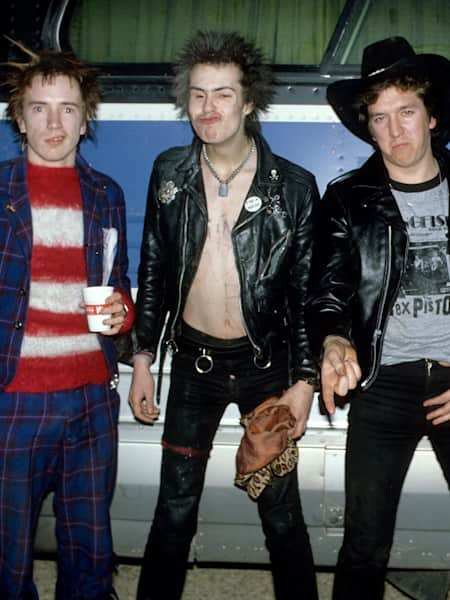Like The Big Lebowski's Dude, punk-rock fashion abides. The main image that probably springs to mind is either that of the goofy street punks with a vertiginous mohawk or the emo pop-punk kid with sweeping fringe and super-skinny clothes. But punk's sub-genres are legion. The range from cowpunk to ska punk via psychobilly, Celtic punk and Oi! And each one has its own tribal uniform that, in one way or another, usually has its roots in one of the five punk-rock fashions we helpfully explore below.
Glam punk
After the '50s teddy boys in the UK, a proto-punk look came along in the late ’60s and early ’70s courtesy of anti-establishment garage-punk bands such as the MC5 and Iggy Pop and The Stooges, who eschewed flowery psychedelia for a grubbier, darker, more unkempt look that expressed their lifestyle. Tight-fitting jeans and black leather, along with buckets of androgyny. This eventually morphed into '70s glam punk, epitomised by the New York Dolls, whose backcombed hair, glitter and make-up caked faces, bright hair and mix of gender-bending clothing was a dissolute reaction to the meat-and-potatoes-rock look that dominated at the time.
CBGB punk
Perhaps the first official US punk look, however, was worn by the New York City bands based around the iconic venue, CBGB. Bands such as The Ramones, Patti Smith, Blondie, Television and Richard Hell. They kept it grubby, anti-materialistic and simple. Jeans, t-shirt and leather jackets, thrift store suits and cheap second-hand slacks and shirts, and Converse and Dr. Martens boots. For working-class kids like The Ramones, their uniform was cheap out of necessity. But either way, with their focus on doing something generation-defining musically, their clothes took on a fell-out-of-bed look that lives on to this day.
King's Road punk
Inspired by the torn, dissolute threads worn by Richard Hell as well as the provocative androgyny of New York Dolls, Sex Pistols’ impresario Malcolm McLaren and fashion designer Vivienne Westwood introduced a new look for the birth of UK punk in 1976 from their shop on London’s King’s Road, SEX. The Pistols were regulars there, as were Adam Ant, Siouxsie Sioux and other members of punk's Bromley Contingent, looking for ripped, sexually explicit, blasphemous and politically antagonistic t-shirts, S&M fetish wear, and outfits inspired by A Clockwork Orange’s droogs. The idea was to shock and offend, which they succeeded in doing magnificently. Other punks, like The Clash, created their own clothes DIY style, writing situationist slogans on t-shirts with marker pen.
Anarcho punk
Anarcho-punk fashion was an evolution of the King’s Road look but, courtesy of bands such as Crass, Subhumans and Discharge, it shot off in a harder-edged, militaristic direction with lots of black clothing, anarchist symbols, mad, coloured hair styles – including gravity-defying mohawks and liberty spikes – band or political t-shirts, and tight trousers and boots. These right-on punks, who have a lot in common with crust punks and European street punks style-wise, are often militant vegans as well as anti-capitalists and shy away from real leather and un-reputable clothing brands.
Skate punk
Washington D.C. and Southern California's hardcore punk scenes of the late '70s and early '80s were clad in utilitarian, universal fashion. What the kids working at the local drugstore or petrol station were wearing, basically. Nothing outré or weird. Just jeans or cut-off shorts, plain t-shirts or shirts, and sneakers or Dr Martens boots. Whatever allowed the likes of Minor Threat and Black Flag, and their fans, the freedom to rage. Hair was invariably short and any jewellery of the spiky variety was ditched in case of injury. It's out of this that skate punk emerged, with bands such as Lagwagon and NOFX throwing khaki work pants, baggy three-quarter length shorts and wallet chains into the mix. Green Day, Blink-182 and the rest of the pop-punk posse took on a similar style tip.









